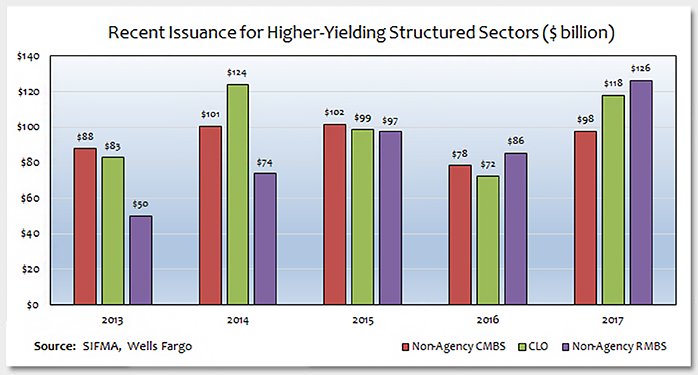This week’s chart demonstrates recent annual issuance for higher-yielding domestic sectors in structured credit. Many investors took substantial losses in non-agency commercial mortgage-backed securities (CMBS) and residential mortgage-backed securities (RMBS) during the crisis. U.S. collateralized loan obligations (CLO) however, took a mark-to-market hit, but subsequently recovered with minimal losses. Many institutional investors have gotten back in the saddle since the crisis and are now investing in structured credit again.
Investors looking for incremental yield by becoming more involved in structured credit, take note: The above chart highlights a few of the main sources of supply for yield in the structured credit arena. Are you involved or willing to become involved in all three of these sectors, or will you pick your spots? Of the three sectors represented in this week’s chart, CLO has been finding increased sponsorship over the past several years. For those investors that have recently returned to the CLO space, or are considering doing so, below are some high-level points to keep in mind when deciding how to frame your credit analysis in the sector:
(1) Speed: How quickly can an investor respond to opportunities when buying or selling? This is directly tied into the strength of their platform, analytics, and access to deal documentation.
(2) Relationships: Does the investor have good relationships with the street? This can lead to opportunities where one investor can get a look on a bond before another investor.
(3) Collateral: How well is the investor able to analyze the collateral and understand the associated risks? Does the investor have credit analysts dedicated to or involved in analyzing all or a portion of the credits underlying their CLOs? Does the investor have sufficient surveillance analytics in place to monitor the changing composition of the collateral?
(4) Structure: How well does the investor understand the different structural features? Does the investor read the documents? Does the investor understand some of the tradeoffs between debtholders and equityholders? Does the investor understand how to properly analyze callability?
(5) Market involvement: Does the investor participate in both new issue and secondary CLOs? Does the investor participate in both CLO debt and CLO equity? There are benefits to being involved in all of these areas.
(6) Managers: Does the investor have the ability to monitor manager performance and detect strategic changes and style drift? Does the investor meet with CLO managers on a regular basis? Does the investor have good relationships with these CLO managers? This can help with transparency and allocations.
(7) Underwriting: Is the investor disciplined, and maintaining a robust, bottom-up, deep-credit approach to analysis? Investors have observed underwriting slippage in the CLO sector over the past few months, particularly related to new features appearing in deal documents, which highlights the importance of this kind of approach.
Key TakeawayNine years after the crisis, investors have gradually returned to the structured credit space. Post-crisis versions of these once troubling sectors can provide some attractive return opportunities. For those who understand the risks involved and how to analyze the securities, CLOs can be compelling, particularly in a rising interest rate environment. CLOs have benefitted from increased sponsorship over the past few years. Some of the key factors to consider when analyzing CLO are given, but risk landscapes can change quickly, so it is important for investors to have a flexible approach to analysis in order to adapt to new risk environments.
The material provided here is for informational use only. The views expressed are those of the author, and do not necessarily reflect the views of Penn Mutual Asset Management.
This material is for informational use only. The views expressed are those of the author, and do not necessarily reflect the views of Penn Mutual Asset Management. This material is not intended to be relied upon as a forecast, research or investment advice, and it is not a recommendation, offer or solicitation to buy or sell any securities or to adopt any investment strategy.
Opinions and statements of financial market trends that are based on current market conditions constitute judgment of the author and are subject to change without notice. The information and opinions contained in this material are derived from sources deemed to be reliable but should not be assumed to be accurate or complete. Statements that reflect projections or expectations of future financial or economic performance of the markets may be considered forward-looking statements. Actual results may differ significantly. Any forecasts contained in this material are based on various estimates and assumptions, and there can be no assurance that such estimates or assumptions will prove accurate.
Investing involves risk, including possible loss of principal. Past performance is no guarantee of future results. All information referenced in preparation of this material has been obtained from sources believed to be reliable, but accuracy and completeness are not guaranteed. There is no representation or warranty as to the accuracy of the information and Penn Mutual Asset Management shall have no liability for decisions based upon such information.
High-Yield bonds are subject to greater fluctuations in value and risk of loss of income and principal. Investing in higher yielding, lower rated corporate bonds have a greater risk of price fluctuations and loss of principal and income than U.S. Treasury bonds and bills. Government securities offer a higher degree of safety and are guaranteed as to the timely payment of principal and interest if held to maturity.
All trademarks are the property of their respective owners. This material may not be reproduced in whole or in part in any form, or referred to in any other publication, without express written permission.


